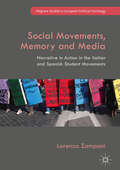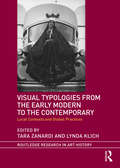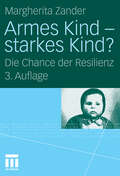- Table View
- List View
Indebted: How Families Make College Work at Any Cost
by Caitlin ZaloomHow the financial pressures of paying for college affect the lives and well-being of middle-class familiesThe struggle to pay for college is one of the defining features of middle-class life in America today. At kitchen tables all across the country, parents agonize over whether to burden their children with loans or to sacrifice their own financial security by taking out a second mortgage or draining their retirement savings. Indebted takes readers into the homes of middle-class families throughout the nation to reveal the hidden consequences of student debt and the ways that financing college has transformed family life.Caitlin Zaloom gained the confidence of numerous parents and their college-age children, who talked candidly with her about stressful and intensely personal financial matters that are usually kept private. In this remarkable book, Zaloom describes the profound moral conflicts for parents as they try to honor what they see as their highest parental duty—providing their children with opportunity—and shows how parents and students alike are forced to take on enormous debts and gamble on an investment that might not pay off. What emerges is a troubling portrait of an American middle class fettered by the "student finance complex"—the bewildering labyrinth of government-sponsored institutions, profit-seeking firms, and university offices that collect information on household earnings and assets, assess family needs, and decide who is eligible for aid and who is not.Superbly written and unflinchingly honest, Indebted breaks through the culture of silence surrounding the student debt crisis, revealing the unspoken costs of sending our kids to college.
Indebted: How Families Make College Work at Any Cost
by Caitlin ZaloomHow the financial pressures of paying for college affect the lives and well-being of middle-class familiesThe struggle to pay for college is a defining feature of middle-class life in America. Caitlin Zaloom takes readers into homes of families throughout the nation to reveal the hidden consequences of student debt and the ways that financing college has transformed our most sacred relationships. She describes the profound moral conflicts for parents as they try to honor what they see as their highest parental duty—providing their children with opportunity—and shows how parents and students alike are forced to gamble on an investment that might not pay off. Superbly written and unflinchingly honest, Indebted breaks through the culture of silence surrounding the student debt crisis, exposing the unspoken costs of sending our kids to college.
Indebted: How Families Make College Work at Any Cost
by Caitlin ZaloomHow the financial pressures of paying for college affect the lives and well-being of middle-class familiesThe struggle to pay for college is a defining feature of middle-class life in America. Caitlin Zaloom takes readers into homes of families throughout the nation to reveal the hidden consequences of student debt and the ways that financing college has transformed our most sacred relationships. She describes the profound moral conflicts for parents as they try to honor what they see as their highest parental duty—providing their children with opportunity—and shows how parents and students alike are forced to gamble on an investment that might not pay off. Superbly written and unflinchingly honest, Indebted breaks through the culture of silence surrounding the student debt crisis, exposing the unspoken costs of sending our kids to college.
Out of the Pits: Traders and Technology from Chicago to London
by Caitlin ZaloomFrom New York to Singapore, from Chicago to London, the trading floors of the world’s financial markets are icons of global capitalism. Images of them are used on the news all the time—traders burying their heads in their hands when the market is down, their arms flailing in a frenzy when fortunes are rising—to convey the current state of the economy. But these marketplaces, and the cultural life that sustains them, are dissolving into the ether of the digital age: powerful financial institutions are shutting down the trading pits, replacing face-to-face exchanges with an electronic network where traders sit, face to screen, finger to mouse, and compete in a global arena made up of digits and charts. Out of the Pits considers the implications of this sea change for everyone involved, from the traders and brokers to the market as a whole. Caitlin Zaloom takes us down to the floor at the Chicago Board of Trade and into a digital dealing room in the City of London. Drawing on her own firsthand experiences as a clerk and a trader and on her unusual access to these key sites of global finance, she explainshow changes at the world’s leading financial exchanges have transformed economic cultures and the craft of speculation; how people and places are responding to the digital transition; how traders are remaking themselves to compete in the contemporary marketplace; and how brokers, business managers, and software designers are collaborating to build new financial markets. A penetrating and richly detailed account of how cities, culture, and technology shape everyday life in the new global economy, Out of the Pits will be must reading for business buffs or anyone who has ever wondered how financial markets work.
Challenging Colonial Administrative Behavior in Bangladesh
by Hasanuzzaman ZamanThis book studies public policy and administration in Bangladesh. It studies how, despite recording high-levels of corruption persistently, some governments in least developed countries (LDCs) like Bangladesh have achieved impressive online transformation level, through digital, electronic or e-Government implementation. The book investigates the historical and political context, and examines the different policies and strategies adopted by successive governments of Bangladesh for facilitating digital service delivery transformation of traditional, paper-based, circuitous public service delivery processes. It reviews public administration reforms introduced over several decades, and other initiatives launched with the specific objective of improving service delivery management. The volume also contextualizes the new e-Government development initiatives in light of the various approaches such as traditional public administration, new public management, digital era governance, new public governance, and design thinking. Drawing on a host of published and unpublished materials, interviews with senior public officials, academics, representatives of international donor agencies, think tanks and non-governmental organizations, and a survey of more than 400 plus bureaucrats, the book analyzes the progress of digital government in Bangladesh from a soft, behavioral perspective. It will be of great interest to scholars and researchers of public policy and public administration, politics, innovation, and South Asian studies. It will be an essential reading for bureaucrats and government officials, as well as think tanks and NGOs.
Challenging Colonial Administrative Behavior in Bangladesh
by Hasanuzzaman ZamanThis book studies public policy and administration in Bangladesh. It studies how, despite recording high-levels of corruption persistently, some governments in least developed countries (LDCs) like Bangladesh have achieved impressive online transformation level, through digital, electronic or e-Government implementation. The book investigates the historical and political context, and examines the different policies and strategies adopted by successive governments of Bangladesh for facilitating digital service delivery transformation of traditional, paper-based, circuitous public service delivery processes. It reviews public administration reforms introduced over several decades, and other initiatives launched with the specific objective of improving service delivery management. The volume also contextualizes the new e-Government development initiatives in light of the various approaches such as traditional public administration, new public management, digital era governance, new public governance, and design thinking. Drawing on a host of published and unpublished materials, interviews with senior public officials, academics, representatives of international donor agencies, think tanks and non-governmental organizations, and a survey of more than 400 plus bureaucrats, the book analyzes the progress of digital government in Bangladesh from a soft, behavioral perspective. It will be of great interest to scholars and researchers of public policy and public administration, politics, innovation, and South Asian studies. It will be an essential reading for bureaucrats and government officials, as well as think tanks and NGOs.
Philosophies of Islamic Education: Historical Perspectives and Emerging Discourses (Routledge Research in Religion and Education)
by Mujadad Zaman Nadeem A. MemonThe study of Islamic education has hitherto remained a tangential inquiry in the broader focus of Islamic Studies. In the wake of this neglect, a renaissance of sorts has occurred in recent years, reconfiguring the importance of Islam’s attitudes to knowledge, learning and education as paramount in the study and appreciation of Islamic civilization. Philosophies of Islamic Education, stands in tandem to this call and takes a pioneering step in establishing the importance of its study for the educationalist, academic and student alike. Broken into four sections, it deals with theological, pedagogic, institutional and contemporary issues reflecting the diverse and often competing notions and practices of Islamic education. As a unique international collaboration bringing into conversation theologians, historians, philosophers, teachers and sociologists of education Philosophies of Islamic Education intends to provide fresh means for conversing with contemporary debates in ethics, secularization theory, child psychology, multiculturalism, interfaith dialogue and moral education. In doing so, it hopes to offer an important and timely contribution to educational studies as well as give new insight for academia in terms of conceiving learning and education.
Transdisciplinary Urbanism and Culture: From Pedagogy to Praxis (The Urban Book Series)
by Quazi Mahtab Zaman Igea TroianiThis book presents a collection of critical, multi-disciplinary essays on urban research by established and early career researchers who participated in the 9th Annual AHRA (Architectural Humanities Research Association) Research Student Symposium. The symposium was held at the Scott Sutherland School of Architecture and Built Environment, Robert Gordon University in Aberdeen from Saturday 19th May to Sunday 20th May 2012. The authors highlight contemporary research issues in urban development in search of new and fresh approaches that reflect the changing principles and praxis of urban conditions. The common ambition is to create new lines of knowledge in urban research. Due to socio-economic, political and technological changes to urban production and patterns of consumption, and a drive for inter-, cross-, multi- and transdisciplinary practice, the essays also reflect the ideological shift currently underway in academic faculties and external research organisations.
Islamic Traditions of Refuge in the Crises of Iraq and Syria (Religion and Global Migrations)
by Tahir ZamanThis book considers positions refugees take relative to the state, humanitarian actors and faith-based organisations in the humanitarian field. Attention is drawn to refugee agency as they negotiate circumstances of considerable constraint demonstrating relational dimensions of religious practice and experience.
Detection of Intrusions and Malware, and Vulnerability Assessment: 5th International Conference, DIMVA 2008, Paris, France, July 10-11, 2008, Proceedings (Lecture Notes in Computer Science #5137)
by Diego ZamboniRecent Advances in Intrusion Detection: 9th International Symposium, RAID 2006, Hamburg, Germany, September 20-22, 2006, Proceedings (Lecture Notes in Computer Science #4219)
by Diego Zamboni Christopher KruegelThis book constitutes the refereed proceedings of the 9th International Symposium on Recent Advances in Intrusion Detection, RAID 2006, held in Hamburg, Germany in September 2006. The 16 revised full papers presented were carefully reviewed and selected from 93 submissions. The papers are organized in topical sections on anomaly detection, attacks, system evaluation and threat assessment, malware collection and analysis, anomaly- and specification-based detection, and network intrusion detection.
The Oxford Handbook of Behavioral Economics and the Law (Oxford Handbooks)
by Eyal ZamirThe past twenty years have witnessed a surge in behavioral studies of law and law-related issues. These studies have challenged the application of the rational-choice model to legal analysis and introduced a more accurate and empirically grounded model of human behavior. This integration of economics, psychology, and law is breaking exciting new ground in legal theory and the social sciences, shedding a new light on age-old legal questions as well as cutting edge policy issues. The Oxford Handbook of Behavioral Economics and Law brings together leading scholars of law, psychology, and economics to provide an up-to-date and comprehensive analysis of this field of research, including its strengths and limitations as well as a forecast of its future development. Its 29 chapters organized in four parts. The first part provides a general overview of behavioral economics. The second part comprises four chapters introducing and criticizing the contribution of behavioral economics to legal theory. The third part discusses specific behavioral phenomena, their ramifications for legal policymaking, and their reflection in extant law. Finally, the fourth part analyzes the contribution of behavioral economics to fifteen legal spheres ranging from core doctrinal areas such as contracts, torts and property to areas such as taxation and antitrust policy.
Behavioral Law and Economics
by Eyal Zamir Doron TeichmanIn the past few decades, economic analysis of law has been challenged by a growing body of experimental and empirical studies that attest to prevalent and systematic deviations from the assumptions of economic rationality. While the findings on bounded rationality and heuristics and biases were initially perceived as antithetical to standard economic and legal-economic analysis, over time they have been largely integrated into mainstream economic analysis, including economic analysis of law. Moreover, the impact of behavioral insights has long since transcended purely economic analysis of law: in recent years, the behavioral movement has become one of the most influential developments in legal scholarship in general. Behavioral Law and Economics offers a state-of-the-art overview of the field. Eyal Zamir and Doron Teichman survey the entire body of psychological research that lies at the basis of behavioral analysis of law, and critically evaluate the core methodological questions of this area of research. Following this, the book discusses the fundamental normative questions stemming from the psychological findings on bounded rationality, and explores their implications for setting the law's goals and designing the means to attain them. The book then provides a systematic and critical examination of the contributions of behavioral studies to all major fields of law including: property, contracts, consumer protection, torts, corporate, securities regulation, antitrust, administrative, constitutional, international, criminal, and evidence law, as well as to the behavior of key players in the legal arena: litigants and judicial decision-makers.
BEHAVIORAL LAW & ECONOMICS C
by Eyal Zamir Doron TeichmanIn the past few decades, economic analysis of law has been challenged by a growing body of experimental and empirical studies that attest to prevalent and systematic deviations from the assumptions of economic rationality. While the findings on bounded rationality and heuristics and biases were initially perceived as antithetical to standard economic and legal-economic analysis, over time they have been largely integrated into mainstream economic analysis, including economic analysis of law. Moreover, the impact of behavioral insights has long since transcended purely economic analysis of law: in recent years, the behavioral movement has become one of the most influential developments in legal scholarship in general. Behavioral Law and Economics offers a state-of-the-art overview of the field. Eyal Zamir and Doron Teichman survey the entire body of psychological research that lies at the basis of behavioral analysis of law, and critically evaluate the core methodological questions of this area of research. Following this, the book discusses the fundamental normative questions stemming from the psychological findings on bounded rationality, and explores their implications for setting the law's goals and designing the means to attain them. The book then provides a systematic and critical examination of the contributions of behavioral studies to all major fields of law including: property, contracts, consumer protection, torts, corporate, securities regulation, antitrust, administrative, constitutional, international, criminal, and evidence law, as well as to the behavior of key players in the legal arena: litigants and judicial decision-makers.
Alchemy, Paracelsianism, and Shakespeare’s The Winter’s Tale (Palgrave Studies in Literature, Science and Medicine)
by Martina ZamparoThis book explores the role of alchemy, Paracelsianism, and Hermetic philosophy in one of Shakespeare’s last plays, The Winter’s Tale. A perusal of the vast literary and iconographic repertory of Renaissance alchemy reveals that this late play is imbued with several topoi, myths, and emblematic symbols coming from coeval alchemical, Paracelsian, and Hermetic sources. It also discusses the alchemical significance of water and time in the play’s circular and regenerative pattern and the healing role of women. All the major symbols of alchemy are present in Shakespeare’s play: the intertwined serpents of the caduceus, the chemical wedding, the filius philosophorum, and the so-called rex chymicus. This book also provides an in-depth survey of late Renaissance alchemy, Paracelsian medicine, and Hermetic culture in the Elizabethan and Jacobean ages. Importantly, it contends that The Winter’s Tale, in symbolically retracing the healing pattern of the rota alchemica and in emphasising the Hermetic principles of unity and concord, glorifies King James’s conciliatory attitude.
Social Movements, Memory and Media: Narrative in Action in the Italian and Spanish Student Movements (Palgrave Studies in European Political Sociology)
by Lorenzo ZamponiCultural factors shape the symbolic environment in which contentious politics take place. Among these factors, collective memories are particularly relevant: they can help collective action by providing symbolic material from the past, but at the same time they can constrain people's ability to mobilise by imposing proscriptions and prescriptions. This book analyses the relationship between social movements and collective memories: how do social movements participate in the building of public memory? And how does public memory, and in particular the media’s representation of a contentious past, influence strategic choices in contemporary movements? To answer these questions the book draws its focus on the evolution of the representation of specific events in the Italian and Spanish student movements of the 1960s and 1970s. Furthermore, through qualitative interviews to contemporary student activists in both countries, it investigates the role of past waves of contention in shaping the present through the publicly discussed image of the past.
Social Movements, Memory and Media: Narrative in Action in the Italian and Spanish Student Movements (Palgrave Studies in European Political Sociology)
by Lorenzo ZamponiCultural factors shape the symbolic environment in which contentious politics take place. Among these factors, collective memories are particularly relevant: they can help collective action by providing symbolic material from the past, but at the same time they can constrain people's ability to mobilise by imposing proscriptions and prescriptions. This book analyses the relationship between social movements and collective memories: how do social movements participate in the building of public memory? And how does public memory, and in particular the media’s representation of a contentious past, influence strategic choices in contemporary movements? To answer these questions the book draws its focus on the evolution of the representation of specific events in the Italian and Spanish student movements of the 1960s and 1970s. Furthermore, through qualitative interviews to contemporary student activists in both countries, it investigates the role of past waves of contention in shaping the present through the publicly discussed image of the past.
Housing Policy and Vulnerable Families in The Inner City: Public Housing in Harlem, New York City (SpringerBriefs in Geography)
by Brigitte ZamzowThis book provides insights in how the lack of coherent social policy leads to the displacement of vulnerable low-income families in inner-city neighborhoods facing gentrification. First, it makes a case for how social policy by its racist setup has failed vulnerable families in the history of U.S. public housing. Second, it shows that today’s public housing transformation puts the same disadvantaged socio-economic clientele at risk, while the neighborhoods they call their homes are taken over by gentrification. It raises the powerful argument that the continuing privatization of Housing Authorities in the U.S. will likely lead to greater income diversity in formerly neglected neighborhoods, but it will happen at the expense of vulnerable families being displaced and resegregated further outside the city, if no regulatory planning measures for their protection are initiated by the government. By providing a solid empirical portrait of public housing in New York City’s Harlem, this book provides a great resource to students, academics and planners interested in gentrification with specific concern for race and class.
Visual Typologies from the Early Modern to the Contemporary: Local Contexts and Global Practices (Routledge Research in Art History)
by Tara Zanardi Lynda KlichVisual Typologies from the Early Modern to the Contemporary investigates the pictorial representation of types from the sixteenth to the twenty- first century. Originating in longstanding visual traditions, including street crier prints and costume albums, these images share certain conventions as they seek to convey knowledge about different peoples. The genre of the type became widespread in the early modern period, developing into a global language of identity. The chapters explore diverse pictorial representations of types, customs, and dress in numerous media, including paintings, prints, postcards, photographs, and garments. Together, they reveal that the activation of typological strategies, including seriality, repetition, appropriation, and subversion has produced a universal and dynamic pictorial language. Typological images highlight the tensions between the local and the international, the specific and the communal, and similarity and difference inherent in the construction of identity. The first full- length study to treat these images as a broader genre, Visual Typologies gives voice to a marginalized form of representation. Together, the chapters debunk the classification of such images as unmediated and authentic representations, offering fresh methodological frameworks to consider their meanings locally and globally, and establishing common ground about the operations of objects that sought to shape, embody, or challenge individual and collective identities.
Visual Typologies from the Early Modern to the Contemporary: Local Contexts and Global Practices (Routledge Research in Art History)
by Tara Zanardi Lynda KlichVisual Typologies from the Early Modern to the Contemporary investigates the pictorial representation of types from the sixteenth to the twenty- first century. Originating in longstanding visual traditions, including street crier prints and costume albums, these images share certain conventions as they seek to convey knowledge about different peoples. The genre of the type became widespread in the early modern period, developing into a global language of identity. The chapters explore diverse pictorial representations of types, customs, and dress in numerous media, including paintings, prints, postcards, photographs, and garments. Together, they reveal that the activation of typological strategies, including seriality, repetition, appropriation, and subversion has produced a universal and dynamic pictorial language. Typological images highlight the tensions between the local and the international, the specific and the communal, and similarity and difference inherent in the construction of identity. The first full- length study to treat these images as a broader genre, Visual Typologies gives voice to a marginalized form of representation. Together, the chapters debunk the classification of such images as unmediated and authentic representations, offering fresh methodological frameworks to consider their meanings locally and globally, and establishing common ground about the operations of objects that sought to shape, embody, or challenge individual and collective identities.
Motives and Goals in Groups
by Alvin ZanderThe qualities and effectiveness of working groups are determined by the goals of the group and the motives of its members. In Motives and Goals In Groups, Alvin Zander studies the effects of group goals and the reasons why particular group goals are chosen. He examines the origins of such goals, determines their value in terms of the work of the group, and analyzes how goals are affected by members' aspirations to achieve success. Zander assumes the idea that the motives of members are not merely dispositions to obtain personal satisfaction, but are also inclinations to achieve group success.Earlier studies defined and clarified concepts about group achievement. They report on work in the laboratory, using high school students as subjects. In later investigations, these concepts were tested in groups outside the laboratory classrooms, executive boards, industrial crews, and business departments.In the new introduction, Zander brings his book up to date by analyzing members' motives and groups' goals from 1971 to the present day. He examines how current findings amplify results reported in the original book. Among the topics covered are: measurability of a group's objective; the degree of members' confidence in attaining the group's goal; the importance of a group's purpose; external pressures on a group's aspirations; and the reaction of members to their group's performance.Motives and Goals in Groups brings together earlier research for the first careful, scientific study of goals In groups. It is of continuing importance to psychologists, educators, social workers, executives, therapists, and all others who work either in or with groups.
Motives and Goals in Groups
by Alvin ZanderThe qualities and effectiveness of working groups are determined by the goals of the group and the motives of its members. In Motives and Goals In Groups, Alvin Zander studies the effects of group goals and the reasons why particular group goals are chosen. He examines the origins of such goals, determines their value in terms of the work of the group, and analyzes how goals are affected by members' aspirations to achieve success. Zander assumes the idea that the motives of members are not merely dispositions to obtain personal satisfaction, but are also inclinations to achieve group success.Earlier studies defined and clarified concepts about group achievement. They report on work in the laboratory, using high school students as subjects. In later investigations, these concepts were tested in groups outside the laboratory classrooms, executive boards, industrial crews, and business departments.In the new introduction, Zander brings his book up to date by analyzing members' motives and groups' goals from 1971 to the present day. He examines how current findings amplify results reported in the original book. Among the topics covered are: measurability of a group's objective; the degree of members' confidence in attaining the group's goal; the importance of a group's purpose; external pressures on a group's aspirations; and the reaction of members to their group's performance.Motives and Goals in Groups brings together earlier research for the first careful, scientific study of goals In groups. It is of continuing importance to psychologists, educators, social workers, executives, therapists, and all others who work either in or with groups.
Armes Kind - starkes Kind?: Die Chance der Resilienz
by Margherita ZanderDas Buch bietet einen fundierten Einblick in die international viel diskutierte und neuerdings auch in Deutschland lebhaft verfolgte Resilienzforschung. „Resilienz“ bedeutet „seelische Widerstandsfähigkeit“ in belasteten und risikobehafteten Lebenssituationen. Aufwachsen in Armut ist ein zentrales Entwicklungsrisiko für Kinder. Wichtigste Erkenntnis ist, dass „Resilienz“durch pädagogisches und sozialpädagogisches Handeln gefördert werden kann. Bisher fehlte jedoch eine theoretisch fundierte Begründung und eine substanzielle fachliche Erörterung, wie sich das Resilienzkonzept für Kinder und Familien in Armutslagen übertragen und anwenden lässt. Diese Lücke schließt das Buch.
Armes Kind - starkes Kind?: Die Chance der Resilienz
by Margherita ZanderDas Buch bietet einen fundierten Einblick in die international viel diskutierte und neuerdings auch in Deutschland lebhaft verfolgte Resilienzforschung. „Resilienz“ bedeutet „seelische Widerstandsfähigkeit“ in belasteten und risikobehafteten Lebenssituationen. Aufwachsen in Armut ist ein zentrales Entwicklungsrisiko für Kinder. Wichtigste Erkenntnis ist, dass „Resilienz“ durch pädagogisches und sozialpädagogisches Handeln gefördert werden kann. Bisher fehlte jedoch eine theoretisch fundierte Begründung und eine substanzielle fachliche Erörterung, wie sich das Resilienzkonzept für Kinder und Familien in Armutslagen übertragen und anwenden lässt. Diese Lücke schließt das Buch.
Armes Kind - starkes Kind?: Die Chance der Resilienz
by Margherita ZanderDas Buch bietet einen fundierten Einblick in die international viel diskutierte und neuerdings auch in Deutschland lebhaft verfolgte Resilienzforschung. „Resilienz“ bedeutet „seelische Widerstandsfähigkeit“ in belasteten und risikobehafteten Lebenssituationen. Aufwachsen in Armut ist ein zentrales Entwicklungsrisiko für Kinder. Wichtigste Erkenntnis ist, dass „Resilienz“ durch pädagogisches und sozialpädagogisches Handeln gefördert werden kann. Bisher fehlte jedoch eine theoretisch fundierte Begründung und eine substanzielle fachliche Erörterung, wie sich das Resilienzkonzept für Kinder und Familien in Armutslagen übertragen und anwenden lässt. Diese Lücke schließt das Buch.


















